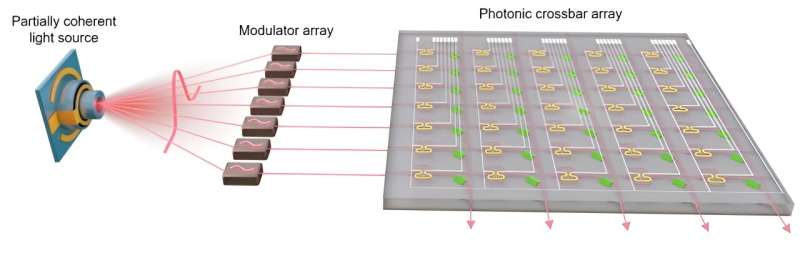
August 2, 2024 by University of Oxford
Collected at: https://phys.org/news/2024-08-game-discovery-driven-artificial-intelligence.html
In a paper, titled “Partial coherence enhances parallelized photonic computing,” published in Nature, researchers from the University of Oxford, along with collaborators from the Universities of Muenster, Heidelberg, and Ghent, report that replacing lasers with less complex light sources can surprisingly boost performance in some optical applications, such as light-driven AI technologies.
This discovery opens the way for cheaper, and less energy-intensive light sources to be used in applications that have typically relied on expensive, high-spec lasers.
The properties of a light source are often characterized by a quantity that physicists call coherence: the degree to which the waves of light are consistent with each other in time and space. Low-coherence light sources, such as the sun and light bulbs, emit light in a wide range of color (or wavelengths).
On the other hand, high quality engineered light sources (such as lasers) have a very narrow wavelength range and typically appear as a single color.
The capability to engineer and use highly coherent light (lasers) has been a bedrock of modern applications such as optical communications, Light Detection and Ranging (LiDAR) remote sensing technologies, and medical imaging technologies. Thus, it was natural to assume that using more coherent light sources enhances system performance and device functionalities, for instance, by enabling higher resolution and more precise measurements.
This new discovery challenges this conventional wisdom and reveals that low coherence light sources can actually function better in specific cases, such as a photonic AI accelerator—an emerging technology where photons are used instead of electrons to perform AI computations.
The team used a partially coherent light source by harnessing a narrow portion of the spectrum of incoherent light produced by an electrically-pumped erbium-doped fiber amplifier (a device used in optical communication to boost the strength of light signals traveling through optical fibers).
This partially coherent light was evenly split and distributed into different input channels for a parallel AI computational array. Using such a light source, the parallelism of AI computation is surprisingly enhanced by N times in a photonic accelerator with N input channels.
As a test case, the team used this system to identify Parkinson’s disease patients by analyzing how they walked, achieving a classification accuracy of over 92%.
The team also demonstrated how a simple system using only one partially coherent light source with nine input channels could be used to perform high-speed AI tasks at around 100 billion operations per second. Normally, such a speed—equivalent to playing more than two hours of 4K video in one second—could only be achieved in a coherent photonic AI accelerator with multiple separate coherent lasers.
Ultimately, removing the need to add additional light sources could prove transformational in boosting computational power, as first author Dr. Bowei Dong at the Department of Materials, University of Oxford, explains, “The benefit of using ‘poorer’ light sources has a scaling effect. You can run your AI models 100 times faster compared to a laser system, if the photonic accelerator scales to 100 input channels.”
Professor Harish Bhaskaran, Department of Materials, University of Oxford and co-founder of Salience Labs, who led the work said, “While this work showcases the use of such partially coherent light in some emerging areas of photonic computing, we will in future also investigate whether this insight might apply to optical communications, particularly in the emerging optical interconnect technology space.
“This is an area of research that is moving rapidly with a lot of interesting science and engineering to explore.”
More information: Bowei Dong et al, Partial coherence enhances parallelized photonic computing, Nature (2024). DOI: 10.1038/s41586-024-07590-y
Journal information: Nature

Leave a Reply